Each week, we'll be bringing you select insights from our newsletter, How to Build Brands and Influence People (HBBIP). To have all of these insights delivered directly to your inbox, subscribe today!
We live in a world of instant gratification. “What have you done for me lately?” is the question on everyone’s lips. Sure, the flowers you sent for my birthday were nice, but why so light on the roses this year? Sure, the newsletter had good numbers last week, but how are we going to improve those numbers for next week?
These totally hypothetical examples, which I definitely didn’t draw from my own life, indicate people’s prioritization of the now. That’s why brands are forever chasing the next viral moment: it represents a chance to briefly dominate a conversation that’s always shifting, and build a platform for future success.
But what about all the unseen, uncelebrated work that comes before those viral moments? How do brands get in the perfect position to capitalize on that mysterious mix of preparation and opportunity?
That brings us to Stanley, and their amazing cups.
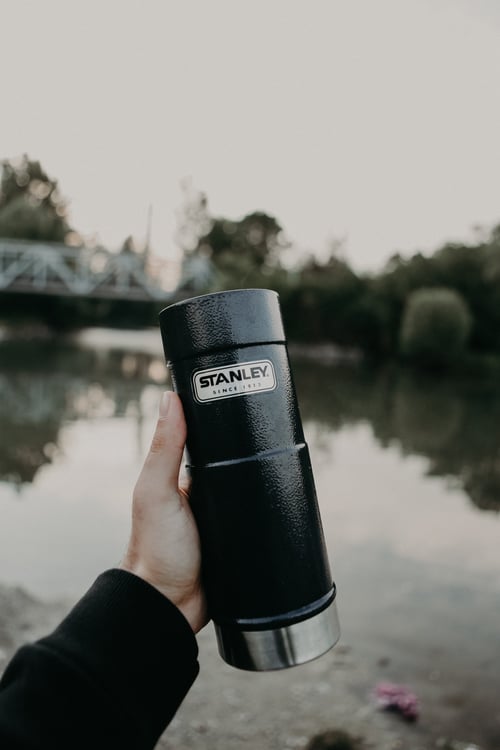
If you’re on TikTok, you probably already know the story, but here’s a refresher just in case: on November 15, a woman—let’s call her Danielle, because that’s her name—suffered a terrible misfortune when her car caught on fire. Amid the charred remains, one particular item stood out: her Stanley-branded tumbler. Not only had the cup emerged from the inferno unscathed, it still had ice in it. Sometimes the ads just write themselves, folks.
(I’m not saying that Stanley set Danielle’s car on fire, then planted that cup full of ice afterwards. I’m just saying that if they had, it would have been a brilliant idea.)
Danielle’s video quickly amassed 60M views on TikTok. While this already constituted tremendous organic engagement for Stanley, the brand acted swiftly and savvily to capitalize on the viral story. In the comments of Danielle’s video, Stanley’s global president Terence Reilly promised her not only a new set of Stanley products, but also a new car. (So if you’re in the market for a new vehicle, might as well give it a shot.)
Here we have all the necessary ingredients for a smash-hit, feel-good story: a misfortune overcome, a brand being a great sport, a drink kept perfectly icy. And the saga did indeed have an instant impact for Stanley. Take a look at the brand’s daily Earned Media Value (EMV) following Danielle’s video:
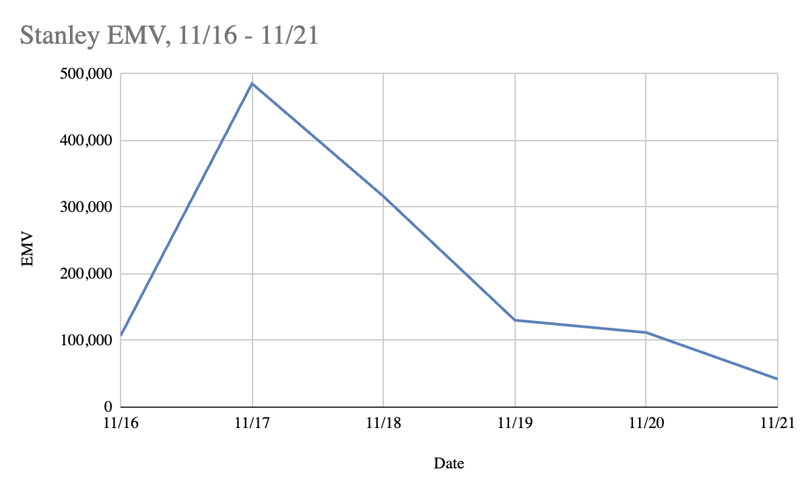 Earned Media Value for Stanley after car fire video in November 2023
Earned Media Value for Stanley after car fire video in November 2023
Yep, that’s a pretty significant impact. And it would make for a pretty solid newsletter feature on its own: wrap it up, everyone go home. But at HBBIP, we bring you the full story, and there’s more here than meets the eye. Because it turns out that Stanley has been doing this for years.
If you Google “stanley cup viral story” for whatever reason—like if, hypothetically, you were writing a newsletter about it—you’d find that the first result isn’t actually related to our friend Danielle and her mishap in November 2023. It’s actually a Buzzfeed article from June 2021 that talks about Stanley’s initial foray into influencer marketing.
It all started when The Buy Guide, a popular product-recommendation Instagram run by three friends, felt organic passion for Stanley’s insulated 40-ounce tumbler. When the product was discontinued, The Buy Guide reached out to a member of Stanley’s PR team. Under the three creators’ direction, Stanley debuted an affiliate program and worked with The Buy Guide to distribute the tumbler to other creators.
Related: How Glow Recipe and Erewhon Win With Influencer Marketing
As further elaborated on in Retail Dive, Stanley asked The Buy Guide trio to place a wholesale order of 10,000 cups. It was a big gamble for both the brand and the creators, with neither party having engaged in such a partnership before.
The results? It took a whole four days for The Buy Guide to sell the first 5,000 cups. But eventually they got their act together, because the second 5,000 cups sold out in under an hour.
Clearly, Stanley was onto something. To the brand’s considerable credit, its executives continued to work with The Buy Guide, revamping Stanley’s promotional strategy to target the 25-to-50-year-old female market. As noted by Retail Guide, the pivot was a massive success: as of the article’s publication date, #StanleyTumbler had accrued 700M views on TikTok.
That article’s publication date? November 14, 2023—one day before Danielle’s car was engulfed in flames. Again, not saying it’s a hoax, but that is some interesting timing.
And yes, both the Buzzfeed and Retail Dive articles open with the same hacky, hokey hockey joke I made at the top of this newsletter, lest you think for a second that I’m original.
That’s a lot of words without any charts. Let’s get into the numbers, which bear out all of what I mentioned above.
Show me Stanley’s EMV from 2020 to 2023—and there better be some good up-and-to-the-right action!
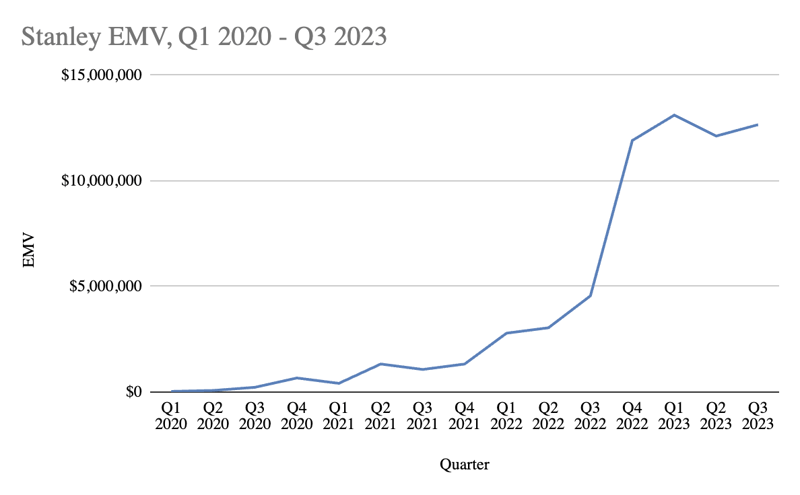 Stanley Earned Media Value from 2020 - 2023, including viral moments
Stanley Earned Media Value from 2020 - 2023, including viral moments
Oh yeah, that’s the stuff.
Stanley’s community size followed a similar trajectory, surging from just 18 creators in Q1 2020 to 2.4k creators in Q3 2023:
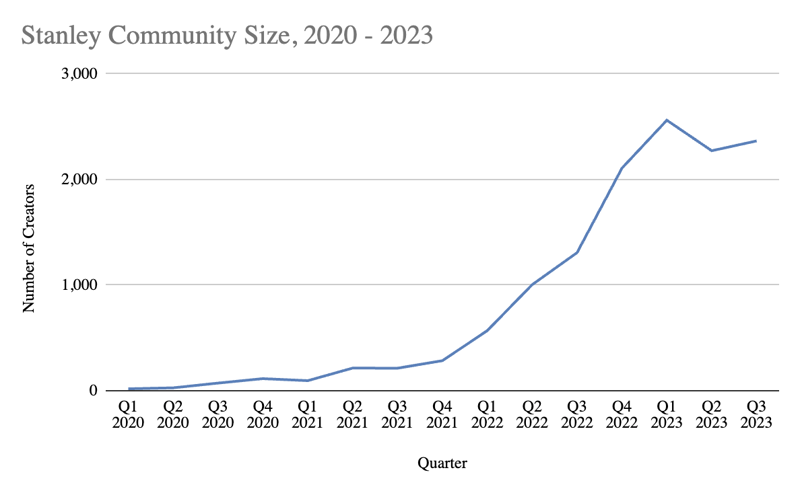 Top 10 Quick-Service Restaurants Creator Community Size Change YoY
Top 10 Quick-Service Restaurants Creator Community Size Change YoY
As can be seen from the above charts, 2023 has represented a culmination of Stanley’s viral strategy, and further proof of the power of creators. Just check out the brand’s stats for January to October 2023 versus January to October 2022—before Danielle left her tumbler in the cupholder, not knowing that history was about to be made:
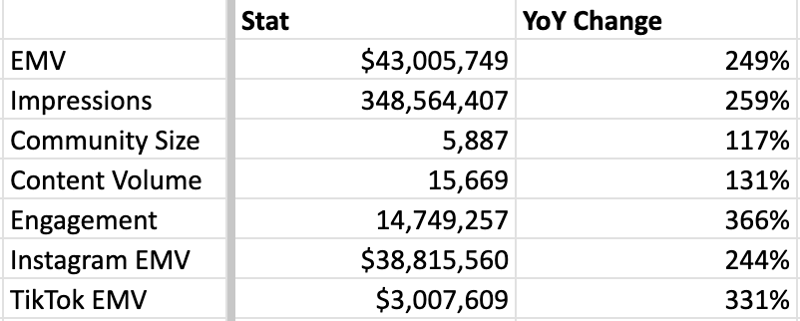 Stanley marketing statistics including impressions, engagement, and # of posts
Stanley marketing statistics including impressions, engagement, and # of posts
When your lowest YoY improvement in a key metric is 117%, you’re probably doing something right. Note how roughly 90% of Stanley’s EMV is coming from Instagram, the platform where The Buying Guide first spread the good word. However, Stanley is seeing even faster adoption on TikTok—a trend that will likely be accelerated by the Danielle Saga.
What do these numbers show? That a car catching on fire didn’t put Stanley on the map. The brand has been working diligently for years to expand its online presence, and even before its latest TikTok campaign, the brand could confidently state that it had arrived. So the next time you’re tempted to ask “what have you done for me lately?”, maybe consider what that person’s already done, and keep in mind that roses are more expensive this year.
As for Stanley, take a bow. Danielle’s video, and the associated followup, were only possible because of the great strides Stanley had already taken to become the internet’s second-favorite tumbler—or even its favorite, if you’re counting all the vowels. It’s one of the more impressive examples of successful creator marketing that I’ve seen during my 7+ years of research, and a lesson for other brands to follow.
Also, can you guys send me a cup? My fingers got really sore writing this newsletter, and I could use something cool to rest them against. Thanks in advance.
This Week’s Headlines
Breaking News: People Buy Stuff
Key Takeaways:
-
- As reported by Business Insider, according to a survey from The Influencer Marketing Factory, social media remains a primary source of commerce for American consumers—and that’s not even factoring in everybody who got in on the game during Black Friday.
- The IMF (no, not that one) polled 1,000 people, of whom 434 said that they had bought at least one product directly on a social media platform in 2023. Beauty products and clothes were the most common purchases, while Facebook was the platform of choice for these digitally savvy shoppers.
- The report cites statistics showing that while U.S. social shopping is a $67B industry in 2023, the phenomenon will rise to $101B in 2025.
The CIQ Perspective:
-
- We’ve been banging this drum for a while—it’s kind of our thing—so it’s nice to see some external validation. With the rise of TikTok Shop and other shopping integrations proliferating across platforms, I wouldn’t be surprised to see the space hit a cool $100B sooner rather than later.
- Speaking of external validation, the Business Insider article cited our good friend Bridget Dolan, Managing Director of YouTube Shopping, who spoke about the success of shoppable short-form videos at “a recent panel in Los Angeles about creators and online shopping.” Um, sorry Business Insider, don’t you mean the recent panel in Los Angeles about creators and online shopping, aka Creator Connect? Check out the playback here.
- I remain in the 56.6% of folks who haven’t purchased anything via a social media platform this year, mainly because I’m not on social media and I don’t like buying stuff. “But Alex, you work in influencer marketing! How can this be?” Look, I’m as surprised as you. Believe me.
Even the Dictionary Reads This Newsletter
Key Takeaways:
-
- Everyone has been talking about authenticity lately. Take it from my good friends Merriam and Webster, who just announced that ‘authentic’ is 2023’s Word of the Year, or the word that best captures the spirit and central questions of the present moment. ‘Authentic’ beat out a fierce challenge from the runner-up Word of the Year, ‘AAAAAHHHHHHHHHHH.’
- The Dictionary cited heightened interest in the term surrounding the rise of AI, artificial images, the complex and ever-shifting discourse on social media, and just generally how nothing feels real anymore.
The CIQ Perspective:
-
- At CreatorIQ, we try to put a more positive spin on “authenticity.” It’s a concept we see in practice every day: from the authentic passion that creators feel for their favorite brands and products, to the authentic enthusiasm that followers feel for their favorite creators, to the authentic U.S. or foreign currency that brands pay CreatorIQ for our services in the influencer marketing sphere.
- Whatever “authentic” means to you, Merriam-Webster’s selection is further indication of the degree to which creators have cemented themselves in the zeitgeist. Look out for 2024’s Words of the Year, ‘GRWM,’ ‘FYP,’ and ‘rizz’ (which was the actual runner-up for 2023).
To get all of these stories, plus much more, delivered to your inbox weekly, be sure to subscribe to our newsletter.

